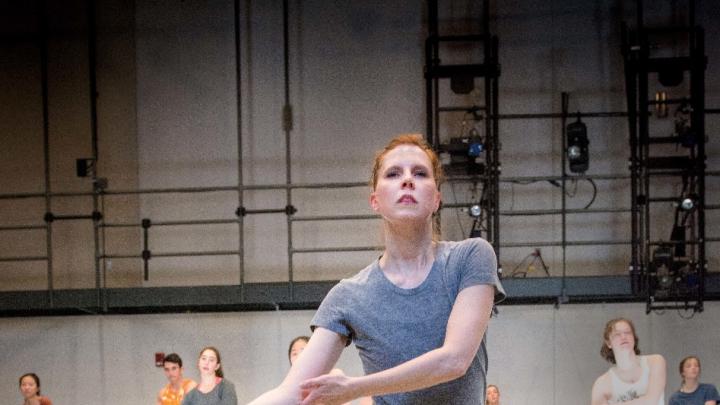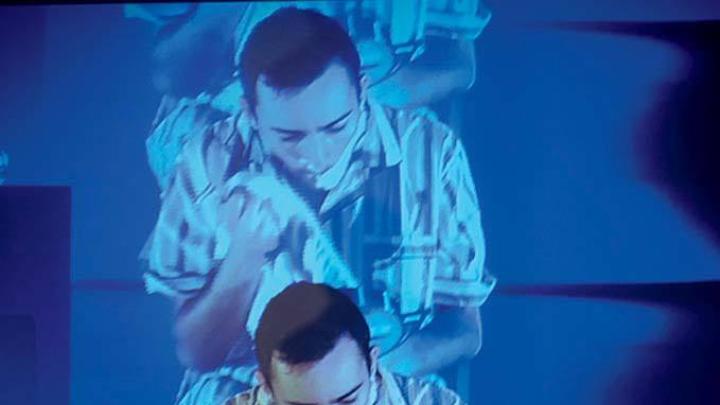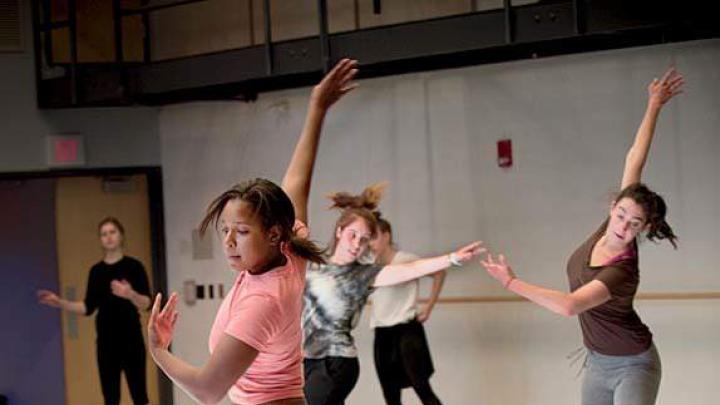Through the door of Martin Puchner’s office in Farkas Hall, bursts of clapping, shouts, and laughter erupt from the class in session next door: “What’s So Funny? Introduction to Improvisational Comedy.” Some 140 students came to the course’s first meeting, says Puchner, and though this case is extreme, in the new Theater, Dance, and Media concentration (TDM), “our classes are at capacity.”
This warm reception might be all the more gratifying because of TDM’s protracted incubation; its faculty likes to call it “400 years in the making.” The program emerged from the determined efforts—reports released, recommendations issued, and priorities identified—of what seems like a matryoshka doll of nested committees: the Task Force on the Arts, chartered by President Drew Faust in 2007; the Harvard University Committee on the Arts in 2009; and finally the Standing Committee on Dramatic Arts, chaired by Puchner, Wien professor of drama and of English and comparative literature, since 2011. Events accelerated last year, after Faust publicly pledged funds toward the concentration’s development in October, and in March, Puchner won unanimous approval from the Faculty of Arts and Sciences for his proposal. Concentrators declared their interest in fall 2015; as of press time, 13 have done so.
Now that TDM has put down roots, its faculty proponents—with considerable student input—look ahead to how it will grow.
“Get Rid of the Binaries”
TDM has been nimbly built around Harvard’s existing theater infrastructure, and draws on those resources. The concentration hired two staff members from the Office for the Arts (OFA) to oversee performance spaces and run mandatory tech and safety workshops; the American Repertory Theater’s (ART) staff and visiting artists teach studio courses and assist with productions. Most of TDM’s history and theory courses are drawn from other departments, including music, English, and various foreign languages—as are most of its regular faculty, with adjuncts and term appointments filling the gaps.
Even the program’s academic structure borrows from a prior source: as in the longstanding secondary field in dramatic arts (which it now replaces), TDM splits requirements evenly between “practice-based” and “theory-based” courses. Without this structure, says Eliza Mantz ’18, “I’d be tempted to take acting classes all the time.” Though in high school Mantz strongly considered attending a conservatory, her studies at Harvard have broadened her idea of how an aspiring performer should be educated: “There’s more to being an artist than movement and voice.”
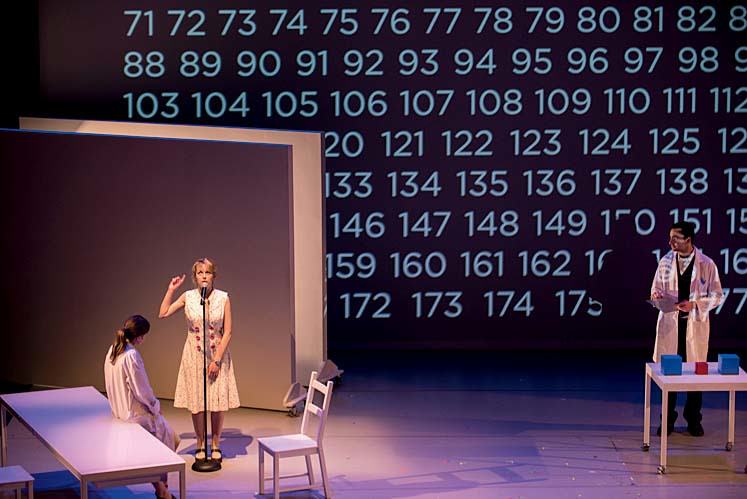
The first TDM concentration show, The Man Who, in dress rehearsal in Farkas Hall
Photograph by Stu Rosner
Sam Hagen ’18, primarily interested in studying theater academically, offers the flip side of that perspective. (He’s in the minority: “In all of these articles that are coming out about TDM, there’s the actors—and then there’s Sam Hagen ’18,” he observes dryly.) Having to go to other departments for theory-based courses makes for a “scattershot” program of study rather than a coherent progression, says Hagen: “I want my major to give everything that it is asking for.”
“Theater is a performance art,” says visiting professor David Chambers, summing up the concentration’s ethos: just as it’s important to verse practitioners of that art in theory and history, “there’s no reason academicians shouldn’t be on their feet figuring out what acting is.” Chambers reports that at Yale, where he’s taught at the School of Drama for several decades, “You’re always fighting that studio-versus-academic division. I actually think one of the hopes for TDM is that we get rid of the binaries. We just get rid of them!” As Puchner puts it: “We are not theater studies. We are theater. And we are theater, dance, and media.”
Students’ early concerns about how TDM might eat up resources, especially performance space, have abated. Undergraduates put on 20 to 30 shows each semester; TDM will stage only two each year, and roles in the cast and technical staff are open to non-concentrators. “We want to be permeable,” says Puchner, who adds that, far from drawing them away from Harvard’s extracurricular scene, “we want to send students back”—equipped with new skills and aesthetic ideas.
The scarcity currently causing tension is not space, but acting credits. TDM requires its students to participate in four productions, half of them within the concentration. Its inaugural show, The Man Who, called for only four actors and cast no concentrators. Future productions will be larger, says Puchner, but he also points to the upside: performers were nudged into apprenticeships with the professional designers on the show’s staff. “Pedagogically speaking,” he says, “that is even more important than who gets to perform.”
The concentration will offer a class in “technical theater” next year, and others agree that TDM could usefully contribute to the performing arts at Harvard by making students more invested in what happens backstage. Jake Stepansky ’17, who serves as vice president of the Harvard-Radcliffe Dramatic Club and, frequently, as a sound designer for student shows, says that the program is “not well-equipped, at the moment, to handle technicians.” Such production roles are often understaffed, he reports, and most students come to Harvard with no design experience and no clear way of gaining it, other than by what he calls “brute-force trial-and-error” as they start to work on shows.
“As an undergraduate who came here to pursue a liberal-arts education, I don’t want a class on microphone etiquette or the acoustics of speakers, or a class on the different kinds of lighting instruments,” Stepansky explains. “But one class on design, looking at a lot of different kinds of design, or design over time? I think there’s totally interest.” Offering a guided, curricular learning environment, he believes, could build student interest in technical matters, and thus strengthen productions as a whole.
“Am I in the Right Place?”
Though their fellow concentrators’ spirits were high, Laurel McCaull ’18 and Kathryn Kearney ’17, both dancers, stood together at TDM’s celebratory meet-and-greet in October feeling more uncertain. Kearney leaned over to McCaull to ask, “Am I in the right place?” “Please, stick it out with me,” McCaull told her, “We can make it work, and make it better.”
Kearney, a member of the Expressions Dance Company, had pursued her interest in dance studies through a concentration in social anthropology. When TDM was made official, she says, “I knew right away that I wanted to do it.” She will now write her senior thesis, on race and ballet, as a joint concentrator. McCaull, a joint concentrator in English who co-directs the Harvard-Radcliffe Modern Dance Company, says that her initial excitement abated once she read through the course offerings: “I was definitely a little underwhelmed with the representation of dance.” After seeing the concentration’s theater-specific requirements, “I almost chickened out.”
As reflected in the course catalog, dance seems to be a junior partner in the concentration. Aside from the Harvard Dance Project, a for-credit ensemble led by OFA Dance Program director Jill Johnson, the concentration offered one dance class in the fall, and two in the spring. While thespians may choose from a menu of courses that spans “Acting Shakespeare” to “Practical Aesthetics” (conceived by playwright David Mamet and actor William H. Macy), dancers have tended to go off-campus for similar training. Some enroll in the Harvard Dance Center’s evening classes, which are open to the Harvard community and charge undergraduates a relatively low fee—but don’t offer credit. “It’s like taking a yoga class or something,” says McCaull. “It’s just not considered serious.”
Meanwhile, studio classes that do offer credit are extremely time-intensive: the Harvard Dance Project, which meets for six hours each week, and for additional rehearsals and performances later in the semester, yields half the credits of a typical course. Deborah Foster, TDM’s director of undergraduate studies, acknowledges that these factors give students little incentive to prioritize practice. Technique classes, she says, “fall by the wayside when the semester gets rolling.”
She and Johnson hope the gap will be bridged by a new hire in a three-year position, adding four more classes a year. The job notice seeks a lecturer to teach technique (in at least one of several suggested fields, including African dance, improvisation, and somatic practices) as well as other courses. The long-rangegoal is a course of study that covers what Johnson calls “the four Cs—classical, contemporary, collaboration, and choreography”; in the meantime, the faculty will deliberate on how Harvard’s dance offerings, once considered purely extracurricular, will “recalibrate to support a degree program.”
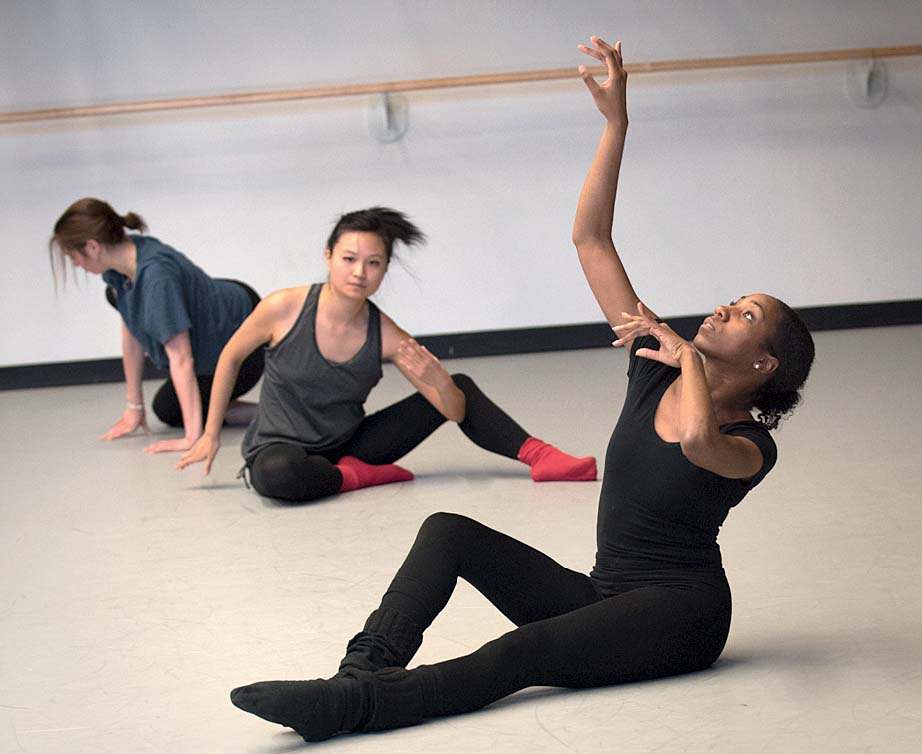
Students in "The Harvard Dance Project,” a two-semester, for-credit ensemble
Photograph by Stu Rosner
“What The Next Thing Will Be”
When asked about the last initial of TDM—“media”—its faculty speak enthusiastically, and at length, about the convergence of technology and the performing arts. They cite an opera they’ve seen that uses digital projections, or a choreographer who uses virtual reality in her work; they point to courses like “Multimedia Experimental Theatre and Performance” and “Live Art in the Theater Environment.” The students have far less clarity about how “media” might meaningfully fit into their program of study. This may be due to a “generational divide,” Foster suggests. “Those of us on the other side of the media revolution see it as having enormous impact on things. Young people who’ve grown up with it maybe don’t see that quite as clearly, because they’re saturated with it.”
But TDM has also intentionally kept the role undefined. “Media” does not chart a third path through the concentration—faculty members insist that even “theater” and “dance” should not be viewed as separate “tracks”—but instead is meant to suggest the program’s receptiveness to the changing identity of the performing arts.
“We want to be open to what the next thing will be. We don’t want to have to contain it, or put a tie on it, or say, ‘This is what media means now,’” explains Johnson, “because that would be to date it before it is out of the gate. It would be a little like predicting our software updates or whatever technology is going to happen in three months—never mind in a year, or six years, or 20.”
In the near future, TDM will expand. “We are hiring in all kinds of categories,” says Puchner. In addition to the dance-lecturer search, they are partnering with the Committee on Studies of Women, Gender, and Sexuality to appoint a College Fellow in a three-year postdoctoral position, and with the English department to find a theater scholar. The concentration also plans to have between four and six visiting lecturers—“artists from New York or elsewhere,” Puchner says—come and teach each year. Even TDM’s physical presence has enlarged, securing dedicated rehearsal space in Hilles Library.
“We’re in a laissez-faire, ‘Let’s learn some stuff’ phase,” says concentrator Aislinn Brophy ’17, president of the Harvard-Radcliffe Dramatic Club. “Which is not to say it’s not rigorous, but it’s a little more, ‘Well, what do you want to do? Let’s try things out! Give us your feedback! Tell us what’s working!’” The faculty feels the same way about their students: Puchner says, with a broad smile, “They are game for anything.”
This article was corrected on April 27, 2016, to reflect that one dance class was offered in the fall 2015 semester, not zero, and that non-credit dance classes are open to the Harvard community, not the general public.
